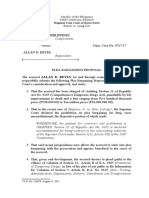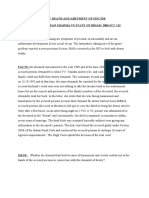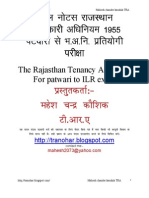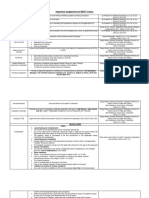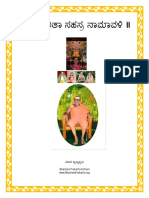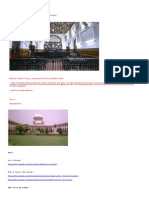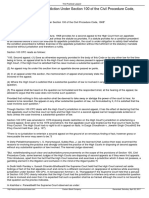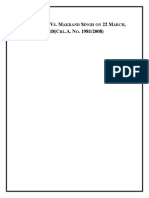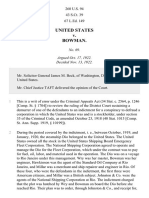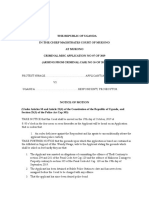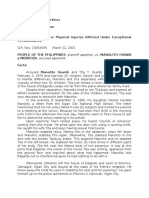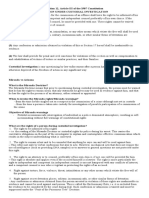Bellur Srinivasa Iyengar Case
Bellur Srinivasa Iyengar Case
Uploaded by
Neeraj GroverCopyright:
Available Formats
Bellur Srinivasa Iyengar Case
Bellur Srinivasa Iyengar Case
Uploaded by
Neeraj GroverCopyright
Available Formats
Share this document
Did you find this document useful?
Is this content inappropriate?
Copyright:
Available Formats
Bellur Srinivasa Iyengar Case
Bellur Srinivasa Iyengar Case
Uploaded by
Neeraj GroverCopyright:
Available Formats
Govinda Reddy And Krishna And Anr.
vs State Of Mysore on 19 August, 1958
Supreme Court of India Govinda Reddy And Krishna And Anr. vs State Of Mysore on 19 August, 1958 Equivalent citations: AIR 1960 SC 29 Author: K S Rao Bench: S Das, N Bhagwati, S D Kapur, K S Rao JUDGMENT K. Subba Rao, J. 1. These four appeals, the first two by Certificate issued by the High Court of Mysore under Article 132(1) of the Constitution of India and the other two by Special Leave granted by this Court under Article 136 of the Constitution of India, arise out of a sensational and gruesome murder of a lawyer of Bangalore and some of the members of his family at Bangalore in Mysore State. 2. The case of the prosecution lies in a small compass and may be stated thus: Belur Srinivasa Iyengar, at the time of his death, was 74 years of age and had amassed substantial properties. His first wife died in 1936 leaving behind her a son, who is said to be insane, and two daughters. After the death of the first wife, he married Vengadamma in February 1937 and had three daughters and three sons by her. Prior to 5th June 1956, Belur Srinivasa Iyengar had fractured his leg and was confined to bed. On the night of 5th June, 1956, the inmates of the house retired to bed as usual. Belur Srinivasa Iyengar was sleeping on a cot in his bed-room. His wife, Vengadamma, her daughter Rangalakshmi, her two sons Lava and Kusha and her mother Singamma were sleeping on three cots in a room adjoining the bed-room of Belur Srinivasa Iyengar. The other two daughters, Ratna and Prasanna, were sleeping in a separate room. Their servant, Ramalingam, was sleeping in the veranda. There was also a watch-dog in the house. Belur Srinivasa Iyengar being a rich man, there were cash, jewels, silver ware and other valuable articles kept in his house in iron-safes, almirahs, trunks and suit cases. On the morning of 6-6-1956, it was discovered that the house was broken into & that some of the inmates of the house, viz., Belur Srinivasa Iyengar, his wife, mother-in-law, his two sons Lava and Kusha and their servant, Ramalingam, were lying dead with serious injuries on their bodies. The dog was also found doped and lying in a dying condition. The valuable articles from the iron-safes, almirahs and other boxes were found removed. Rangalakshmi, a daughter of Belur Srinivasa Iyengar, was found leaning against a wall with bleeding injuries on her head and in an unconscious state. 3. The version of the prosecution is that the appellants, who are related or at any rate closely associated with one another, getting scent of the fact that Belur Srinivasa Iyengar kept cash & valuable jewels in his house, conspired to commit murder and robbery, broke into his house on the night of 5th June, 1956 with deadly weapons, doped the dog, killed the servant, murdered Belur Srinivasa Iyengar, his wife, mother-in-law, two sons Lava and Kusha, caused grievous injuries to Rangalakshmi, took away the booty gathered in the house and divided the spoils amongst themselves. 4. The appellants were charged on the following counts: Section 302 read with Section 34, Indian Penal Code; Section 307 read with Section 34, Indian Penal Code; Section 457 read with Section 34, Indian Penal Code; Section 380 read with Section 34, Indian Penal Code; Section 392 read with Section 34, Indian Penal Code; Section 394, Indian Penal Code; Section 397 read with Section 34, Indian Penal Code and Section 460, Indian Penal Code. The prosecution examined 116 witnesses. No witnesses were examined on behalf of the appellants Nos. 2 and 3. Three witnesses were examined on behalf of the first appellant. There were no eye-witnesses to the incident for the simple reason that all the persons who could have witnessed the occurrence were done away with and the only other member, Rangalakshmi who was sleeping in the same room along with her mother and others, was seriously injured and was in an unconscious state. It is in evidence that she continued to be unconscious for some days after the incident and thereafter also was not in a position to give evidence. The other two daughters, Ratna and Prasanna, who were providentially sleeping in a different room, escaped from being murdered and they came to know of the ghastly incident only on the early morning of the 6th June. In the circumstances the prosecution case was based upon circumstantial evidence.
Indian Kanoon - http://indiankanoon.org/doc/1659721/ 1
Govinda Reddy And Krishna And Anr. vs State Of Mysore on 19 August, 1958
5. The mode of evaluating circumstantial evidence has been stated by this Court in Hanumant Govind Nargundkar v. State of Madhya Pradesh, , and it is as follows: "It is well to remember that in cases where the evidence is of a circumstantial nature, the circumstances from which the conclusion of guilt is to be drawn should in the first instance be fully established, and all the facts so established should be consistent only with the hypothesis of the guilt of the accused. Again, the circumstances should be of a conclusive nature and tendency and they should be such as to exclude every hypothesis but the one proposed to be proved. In other words, there must be a chain of evidence so far complete as not to leave any reasonable ground for a conclusion consistent with the innocence of the accused and it must be such as to show that within all human probability the act must have been done by the accused." Having regard to the aforesaid principle, the learned Sessions Judge and, on appeal, the High Court definitely found the circumstantial facts relating to each of the accused and drew the inference from them that the accused conjointly participated in the commission of the murder and the other offences with which they were charged. On that finding, the learned Sessions Judge convicted them on the counts on which they were charged. On the first count they were sentenced to death and on the other counts they were sentenced to various terms of imprisonment. On appeal, the High Court confirmed the conviction as well as the sentences except in regard to the fourth count, as in its opinion, the offence of theft being an ingredient of the offence of robbery, they should not have been convicted twice over the same offence. The aforesaid appeals were filed by the accused against the sentences of death and imprisonment. 6. The learned Counsel for the appellants contended that an important link in the chain of circumstantial evidence found by the Court below was the fingerprints of the appellants taken by the police during the course of the investigation for the purpose of comparing the same with the finger prints found on the articles scattered in the room in the house of Belur Srinivasa Iyengar, where the incident took place, that the said evidence was inadmissible by reason of Article 20, Clause 3 of the Constitution of India, that if the finger prints were excluded from the evidence, the continuity of the chain would be broken and that in any event there would be no evidence to hold that the three appellants conjointly participated in the commission of the offences with which they were charged. The argument raises an important and interesting question, namely, whether the taking of thumb impressions of the accused by the police during the investigation and their use during the trial would be contrary to the constitutional guarantee given under Article 20(3). In the present case, we are relieved of the duty of expressing our opinion on the said question, as, in our view, even if the facts found on the basis of comparison of the finger prints of the accused taken by the police during investigation with those found on the articles in the house of Belur Srinivasa Iyengar were excluded, the other pieces of evidence were overwhelmingly sufficient to sustain the convictions. 7. We shall now proceed to state the circumstances found by the two Courts against the accused: (i) The appellants are related or at any rate closely associated with one another; (ii) about a fortnight prior to the date of the incident, appellants 2 and 3, along with P. W. 44, Channa, made an unsuccessful attempt to burgle the house of Belur Srinivasa Iyengar for the purpose of committing theft; (iii) on the 5th June 1956, appellants Krishna and Muniswamy purchased crow-bars, M. Os. 1 and 4, in the shop of P. W. 60, Dhanalakshmi and P. W. 61, Ibrahim, respectively and those articles were found in the bed-room of Vengadamma in 'Renga Vilas' on the morning of 6th June, 1956, and they were blood-stained; (iv) the appellants were found moving together on the 5th June 1956; (v) the finger prints of the appellants were found on the silver vessels, M. Os. 86, 87 and 89, which were lying scattered in 'Renga Vilas' on the morning of 6th June 1956 and those finger prints tally with those of the appellants; (vi) jewellery belonging to and in the possession of the members of the family of Belur Srinivasa Iyengar just prior to the commission of the offence were found in the possession of the appellants either on their persons or in their houses; (vii) bloodstained clothes were recovered from a hedge near the house of appellant No. 2, Krishna, on the information furnished by him and from appellant No. 1, Govinda Reddy's house; (viii) the appellant Krishna made several purchases on the 6th and 8th June 1956 and he converted some of the jewels into gold ingots and disposed them of and the two bills for having purchased a cot and an almirah were found on his person on the date he was arrested, that is, on the 9th June,
Indian Kanoon - http://indiankanoon.org/doc/1659721/ 2
Govinda Reddy And Krishna And Anr. vs State Of Mysore on 19 August, 1958
1956. The cot and the almirah, which were yet in an unpacked condition, were found in the house of appellant Krishna, where he was living with his concubine, P. W. 38, Jaytimma, that is in the house bearing No. 21/6-86 Ramakrishna Mutt Road Ulsoor; (ix) The knife, M. O. 3, was recovered from a well behind the house of the second appellant, Krishna, on the information furnished by him and it contained mammalian blood and was identified by several witnesses as belonging to the second appellant Krishna, and as the one that was in his house in premises No. 21/6-86 Ramakrishna Mutt Road, Ulsoor, and which was being used by the inmates of the house for domestic purposes; (x) two half portions of cinema tickets were found On the scene of occurrence. Appellant No. 1, Govinda Reddy, told Basavaraj, P. W. 75, that he and appellant No. 2, Krishna, were going to a cinema; (xi) appellant No. 2, Krishna, suddenly became rich and made several purchases immediately after the date of the incident. 8. The learned Counsel for the appellants, while not disputing the fact that the aforesaid circumstantial evidence would lead to the irresistible conclusion that the three appellants participated in the commission of murder and other offences, argued that if the evidence furnished by the finger prints was excluded, the other evidence left after such exclusion would not justify a conviction under Section 302 read with Section 34, Indian Penal Code and he relied on the decision in Shreekantiah Ramayya Munipalli v. The State of Bombay, . We cannot accept this contention. So far as the appellants 2 and 3 were concerned, it is manifest that the facts found were incompatible with their innocence. In combination with the other facts found, the discovery of the crow-bars, proved to have been purchased by appellants Nos. 2 and 3 Krishna and Muniswamy, in the bedroom of Vengadamma on the 6th June 1956 with blood-stains thereon, establishes beyond any reasonable doubt that these appellants were present in the house of the deceased and took part in the incident. 9. The learned Counsel contended that though the crow-bars were purchased by appellants 2 and 3, it might be that the said crow-bars were handed over to the real culprits for committing the murder and the appellants might have been only the recipients of stolen goods. The principle that the inculpatory fact must be inconsistent with the innocence of the accused and incapable of explanation on any other hypothesis than that of guilt does not mean that any extravagant hypothesis would be sufficient to sustain the principle, but that the hypothesis suggested must be reasonable. It may be that the said fact in itself may not be decisive of the complicity of appellants 2 and 3, but the said fact along with the other facts found may reinforce the conclusion of guilt. In the circumstances of this case, the hypothesis suggested is far fetched and the only reasonable conclusion that a prudent man can come to is that the appellants 2 and 3 had committed the offences. 10. The learned Counsel then made a special pleading in the case of appellant No. 1, Govinda Reddy. He urged that whatever justification there might have been for the finding in the case of appellants Nos. 2 and 3, if the evidence of finger prints was excluded, it would not be possible to hold that the first appellant participated in the commission of the offences and, without such participation, he could not be jointly made liable along with the other two appellants. To meet this argument it would be convenient to restate, with more particularity, the facts found against that appellant: (i) Appellant No. 1 was closely associated with appellants Nos. 2 and 3; (ii) P. W. 38 heard the third accused saying that there were money and jewels in the house of Belur Srinivasa Iyengar and that they should kill them and bring away the properties; (iii) on the day following the unsuccessful attempt, appellant No. 1 came to the house of appellant No. 2 and he was told that, as the dogs barked, they could not succeed in their attempt; (iv) 15 days after the first incident, P. W. 38 heard appellants 1 and 3 asking appellant No. 2 to go again to Belur Srinivasa Iyengar's house and she intervened and said to the first appellant that, being an elderly man, he should not instigate them to do such illegal things and that he should give proper advice to the youngsters; (v) Appellant No. 1 had the special knowledge of the fact that Belur Srinivasa Iyengar was a wealthy man and had a lot of cash and jewels in his house; (vi) on the 5th Jung 1956 at 11 a. m., appellant No. I was expecting appellant No. 2 to meet him at the Ramanatha Cafe. Appellant No. 1, at the request of P. W. 74, went to the "Water Office" and appellant No. 2 came to the Cafe in his absence and asked P. W. 74 to tell appellant No. 1 that he could meet him at 3 p. m.; (vii) at about 8 p.
Indian Kanoon - http://indiankanoon.org/doc/1659721/ 3
Govinda Reddy And Krishna And Anr. vs State Of Mysore on 19 August, 1958
m., the appellants 1 and 2 went to the fuel shop of P. W. 75, Basavaraj, where appellant No. 2 left his motor-cycle, and appellant No. 1 in formed Basavaraj that they were going to the Himalaya Talkies; (viii) two half portions of cinema tickets. Exhibits P-74 and P-74(a), which were proved to be the corresponding half portions of the tickets sold at the Himalaya Talkies, were found on the early morning of the 6th June 1956 in the house of Belur Srinivasa Iyengar; close to the window from which a bar had been wrenched; (ix) the finger impressions of appellant No. 1, Govinda Reddy, were found on the silver cup, M. O. 89, found in the house of the deceased; (x) on the morning of 10th June 1956, the house of the first appellant was searched by P. W. 144 and the panche, M. O. 101, was seized and that it contained stains of human blood; the panche was proved to belong to appellant No. 1; (xi) M. Os. 183, to 185 were recovered from the person of appellant No. 1 at the time of his arrest and it was established that the said jewels belonged to the inmates of Belur Srinivasa Iyengar's house; (xii) no explanation was offered by the first appellant as to how he came into possession of these jewels. 11. Out of the said facts, we are excluding from consideration the evidence furnished by the comparison of the finger prints found on the silver vessels and those taken by the police from the appellants. It was contended that if that fact was excluded, the other facts would not establish that appellant No. 1 participated in the offence of murder and robbery and would be consistent only with his being the receiver of stolen goods. But we cannot agree with this argument. The cumulative effect of the circumstantial evidence found by the Courts, particularly in view of the unacceptable explanation given by appellant No. 1 for the presence of blood stains on his panche and his failure to give any explanation in regard to the possession of the stolen goods a few days after the incident, leave no doubt in our minds that the hypothesis suggested, namely, that appellants 2 and 3 might have committed the murder and given to appellant No. 1 a portion of the spoils, is more fanciful than real. In this particular case, the facts found are not capable of explanation upon any other hypothesis than that the first appellant participated in the commission of the offences of murder and robbery. We agree with the conclusion arrived at by the High Court and hold that the appellants were rightly convicted and sentenced under each count. The appeals are accordingly dismissed.
Indian Kanoon - http://indiankanoon.org/doc/1659721/
You might also like
- Sample Plea Bargaining Proposal For DrugsDocument3 pagesSample Plea Bargaining Proposal For DrugsDanielAlBaniasDelfinNo ratings yet
- Beef Eating in Vedas and Other Hindu TextsDocument36 pagesBeef Eating in Vedas and Other Hindu TextsahmadNo ratings yet
- 1993 Mumbai Bomb Blast Case Supreme Court Judgement Part 5Document168 pages1993 Mumbai Bomb Blast Case Supreme Court Judgement Part 5Sampath BulusuNo ratings yet
- Parivar Paramarsh Kendra EnglishDocument43 pagesParivar Paramarsh Kendra Englishdabster7000100% (1)
- Opposition To A Motion For ReconsiderationDocument3 pagesOpposition To A Motion For ReconsiderationLuwill AlagNo ratings yet
- Forensic CasesDocument17 pagesForensic CasesSAI RISHIITHANo ratings yet
- Shankar Kisanrao Khade Vs State of Maharashtra On 25 April, 2013 PDFDocument47 pagesShankar Kisanrao Khade Vs State of Maharashtra On 25 April, 2013 PDFmkkhortiNo ratings yet
- Auto Shankar CaseDocument9 pagesAuto Shankar CaseUjjwal AaishwaryaNo ratings yet
- State of Bihar Vs L.K. AdvaniDocument6 pagesState of Bihar Vs L.K. AdvaniSanmanNo ratings yet
- MOOT COURT PROBLEM 3rd Year 2016Document5 pagesMOOT COURT PROBLEM 3rd Year 2016alloi0% (1)
- Criminal Antecedents of Accused Cannot Be Ignored While Granting Bail SCDocument17 pagesCriminal Antecedents of Accused Cannot Be Ignored While Granting Bail SCLive LawNo ratings yet
- Supreme Court Judgement On Talwar Review PleaDocument63 pagesSupreme Court Judgement On Talwar Review PleaFirstpost100% (1)
- Ram Badan Sharma Vs State of BiharDocument3 pagesRam Badan Sharma Vs State of BiharNaman KumarNo ratings yet
- VLS Jurisprudence May June 2020 FULL NOTESDocument29 pagesVLS Jurisprudence May June 2020 FULL NOTESqubrex1No ratings yet
- Execution of Death Sentence PDFDocument22 pagesExecution of Death Sentence PDFezhilrasanNo ratings yet
- Notes Compiled BY: Law of EvidanceDocument27 pagesNotes Compiled BY: Law of EvidanceBHAVANINo ratings yet
- 10thddbasumemorial LectureDocument56 pages10thddbasumemorial LectureBruce Wayne100% (1)
- A Seminar On The Law On Stamp Duty and Registration in A (2016!09!07 01-15-08 Utc)Document29 pagesA Seminar On The Law On Stamp Duty and Registration in A (2016!09!07 01-15-08 Utc)akash2199100% (1)
- KNOW INAM ABOLITION ACTS IN KARNATAKA CASE OF M.B. Ramachandran Air 2005 SC 2671Document4 pagesKNOW INAM ABOLITION ACTS IN KARNATAKA CASE OF M.B. Ramachandran Air 2005 SC 2671Sridhara babu. N - ಶ್ರೀಧರ ಬಾಬು. ಎನ್No ratings yet
- Religious Case AnalysisDocument4 pagesReligious Case AnalysisÀdñäñ Håmèéd100% (1)
- Comparative Table of IEA and BSA, 2023Document11 pagesComparative Table of IEA and BSA, 2023Syed Faiqa Shah 51No ratings yet
- Ram Bahadur ThapaDocument4 pagesRam Bahadur ThapaMohandas PeriyasamyNo ratings yet
- SC Sets Aside Concurrent Findings of Courts Below Awarding Compensation To Accused For Malicious ProsecutionDocument13 pagesSC Sets Aside Concurrent Findings of Courts Below Awarding Compensation To Accused For Malicious ProsecutionLive LawNo ratings yet
- Tenancy Act 1955Document8 pagesTenancy Act 1955Rajat YadavNo ratings yet
- Topic - Brandeis Brief: Judicial ProcessDocument16 pagesTopic - Brandeis Brief: Judicial ProcesspillardvsgNo ratings yet
- 40 Landmark Judgments: Hardly An Open-And-Shut Case, The Nature of The Crime Garnered Media AttentionDocument12 pages40 Landmark Judgments: Hardly An Open-And-Shut Case, The Nature of The Crime Garnered Media AttentionAayat 16No ratings yet
- Santosh Kumar Vs State Through CbiDocument6 pagesSantosh Kumar Vs State Through CbiDiwanshu KaRwalNo ratings yet
- Bhadresh Bipinbhai Sheth vs. State of Gujarat & AnotherDocument31 pagesBhadresh Bipinbhai Sheth vs. State of Gujarat & AnotherLive LawNo ratings yet
- Important Judgments For MACT Cases PDFDocument8 pagesImportant Judgments For MACT Cases PDFHitesh PhulwaniNo ratings yet
- Kathua Rape Case PresentationDocument19 pagesKathua Rape Case PresentationSougata SahaNo ratings yet
- Aarushi TalwarDocument9 pagesAarushi TalwarAbhay MalikNo ratings yet
- New Criminal Laws - NotesDocument5 pagesNew Criminal Laws - NotesŘíŢíĶ ChauhanNo ratings yet
- Unnao Rape CaseDocument14 pagesUnnao Rape CaseAnonymous 1Ye0Go7KuNo ratings yet
- Lalita KannadaDocument56 pagesLalita KannadaDurga PrasadNo ratings yet
- Doctrine of Blending - It Is The Coparcener Who Alone Can Blend His Separate Property With Joint Family Property 1977 Air 2230Document10 pagesDoctrine of Blending - It Is The Coparcener Who Alone Can Blend His Separate Property With Joint Family Property 1977 Air 2230Sridhara babu. N - ಶ್ರೀಧರ ಬಾಬು. ಎನ್0% (1)
- Dudh Nath Pandey Vs State of Uttar Pradesh 1102198s810137COM668122Document7 pagesDudh Nath Pandey Vs State of Uttar Pradesh 1102198s810137COM668122mohitpaliwalNo ratings yet
- Contempt Petition For Commutation Arrears Filed by SBM CommuneDocument9 pagesContempt Petition For Commutation Arrears Filed by SBM Communeketan divanNo ratings yet
- Mysore (Personal and Miscellaneous) Inams Abolition Act, 1954Document30 pagesMysore (Personal and Miscellaneous) Inams Abolition Act, 1954sunandeniNo ratings yet
- Moot Court Problem ModelDocument5 pagesMoot Court Problem ModelSahil JainNo ratings yet
- Hindu Women Property RightsDocument15 pagesHindu Women Property RightssujishettyNo ratings yet
- Match Fixing by Judges & PoliceDocument193 pagesMatch Fixing by Judges & PoliceNagaraja Mysuru RaghupathiNo ratings yet
- Stages of CrimeDocument241 pagesStages of Crimedeepika mitraNo ratings yet
- Girl Issue in IndiaDocument17 pagesGirl Issue in IndiamahavirsinghNo ratings yet
- Substantial Question of Law MaterialDocument4 pagesSubstantial Question of Law MaterialVivek SaiNo ratings yet
- 26 Reasons For Sentencing Talwars in Aarushi CaseDocument3 pages26 Reasons For Sentencing Talwars in Aarushi CaseShantanu Chauhan0% (1)
- Judgement Lakhotiya Murder Case NagpurDocument201 pagesJudgement Lakhotiya Murder Case NagpurSampath BulusuNo ratings yet
- Mhetre Anticipatory BailDocument79 pagesMhetre Anticipatory BailRupesh GadekarNo ratings yet
- Utility of Forensic Science in Indian Legal SystemDocument5 pagesUtility of Forensic Science in Indian Legal SystemA. L. JainNo ratings yet
- Relevant Judgements Related To Bail, Part-2Document83 pagesRelevant Judgements Related To Bail, Part-2Shreya MehtaNo ratings yet
- Reduced To AshesDocument655 pagesReduced To Ashesami_4m150% (2)
- Nitish Katara Murder Case Supplementary Case JudgementDocument81 pagesNitish Katara Murder Case Supplementary Case JudgementSampath BulusuNo ratings yet
- Criminology-Penology and Victimology: Detailed Syllabus Marks 1. Introduction - Penology 16Document2 pagesCriminology-Penology and Victimology: Detailed Syllabus Marks 1. Introduction - Penology 16ASWINNo ratings yet
- Making A Mockery of Justice Delhi HC Let Off Rapist Without Trial, Holding That Victim Aged 15 Was Married To The AccusedDocument6 pagesMaking A Mockery of Justice Delhi HC Let Off Rapist Without Trial, Holding That Victim Aged 15 Was Married To The AccusedLive Law100% (1)
- Supreme Court of India Page 1 of 17Document17 pagesSupreme Court of India Page 1 of 17Muhammad SufianNo ratings yet
- Ashish Jain Vs Makrand SinghDocument5 pagesAshish Jain Vs Makrand Singhrandhir singh33% (3)
- Surju Marandi Case LawDocument23 pagesSurju Marandi Case LawNitin SherwalNo ratings yet
- 887 Subramanya V State of Karnataka 13 Oct 2022 441577 Confession of A Co AccusedDocument31 pages887 Subramanya V State of Karnataka 13 Oct 2022 441577 Confession of A Co Accusedtanmay guptaNo ratings yet
- Vijay Pal Singh and Others Vs State of Uttarakhand On 16 December, 2014Document28 pagesVijay Pal Singh and Others Vs State of Uttarakhand On 16 December, 2014SandeepPamaratiNo ratings yet
- Moot Court RespondentDocument12 pagesMoot Court RespondentAman DegraNo ratings yet
- 002 Ashish Jain V Makrand Singh 14-01-2019Document33 pages002 Ashish Jain V Makrand Singh 14-01-2019Harendra SinghNo ratings yet
- Judgment - Extra Judicial Confession of Co-AccusedDocument73 pagesJudgment - Extra Judicial Confession of Co-AccusedShamik NarainNo ratings yet
- Santiago v. Tykol Et AlDocument29 pagesSantiago v. Tykol Et AlMeganNo ratings yet
- United States v. Bowman, 260 U.S. 94 (1922)Document7 pagesUnited States v. Bowman, 260 U.S. 94 (1922)Scribd Government DocsNo ratings yet
- People Vs UybucoDocument3 pagesPeople Vs UybucoMar Jan GuyNo ratings yet
- Consti 2 Syllabus For 03.08.2020Document8 pagesConsti 2 Syllabus For 03.08.2020Abegail Fronteras BuñaoNo ratings yet
- 3 - People V Campuhan, GR 129433Document1 page3 - People V Campuhan, GR 129433Gilbert VasquezNo ratings yet
- Unconditional ReleaseDocument7 pagesUnconditional ReleaseMusiime Katumbire Hillary100% (1)
- Domondon Vs Sandiganbayan DigestDocument2 pagesDomondon Vs Sandiganbayan DigestNash Lasam100% (1)
- Madras City Police Act, 1888 PDFDocument77 pagesMadras City Police Act, 1888 PDFLatest Laws TeamNo ratings yet
- CASE DIGEST - Rodica vs. LazaroDocument2 pagesCASE DIGEST - Rodica vs. LazaroBeanca Marie BabasNo ratings yet
- Final Memorial On The Behalf of RespondentspdfDocument32 pagesFinal Memorial On The Behalf of RespondentspdfZeel RavalNo ratings yet
- De 66 - Joint Motion To Dismiss The Superseding Indictment Based On The Government's Deliberate Invasion of The Defense CampDocument34 pagesDe 66 - Joint Motion To Dismiss The Superseding Indictment Based On The Government's Deliberate Invasion of The Defense CampDavid Oscar MarkusNo ratings yet
- Article 247 - People VS OyanibDocument2 pagesArticle 247 - People VS Oyanibtea waitforit100% (1)
- William R. Phillips, Who Exposed Corruption in The N.Y.P.D., DiesDocument1 pageWilliam R. Phillips, Who Exposed Corruption in The N.Y.P.D., DiesRamonita GarciaNo ratings yet
- UntitledDocument2 pagesUntitledxyji mave ingosanNo ratings yet
- Miranda Vs ArizonaDocument2 pagesMiranda Vs Arizonadavidorlando20No ratings yet
- Sherman A. Godwin v. C. H. Looney, Warden, United States Penitentiary, Leavenworth, Kansas, 250 F.2d 72, 10th Cir. (1957)Document3 pagesSherman A. Godwin v. C. H. Looney, Warden, United States Penitentiary, Leavenworth, Kansas, 250 F.2d 72, 10th Cir. (1957)Scribd Government DocsNo ratings yet
- Crime Prevention: By: Cruz, Ana Luisa Herrera, Ysabel Alexandra Vergara, HannaDocument30 pagesCrime Prevention: By: Cruz, Ana Luisa Herrera, Ysabel Alexandra Vergara, Hannafrizal100% (1)
- Josie NewsaperDocument1 pageJosie Newsaperapi-192240916No ratings yet
- UnpublishedDocument5 pagesUnpublishedScribd Government DocsNo ratings yet
- Corporate Criminal Liability ProjectDocument10 pagesCorporate Criminal Liability ProjectAkash JainNo ratings yet
- Digests 2nd PartDocument11 pagesDigests 2nd PartVince VillanuevaNo ratings yet
- Kenny InvestDocument2 pagesKenny InvestJasper Pineda GermediaNo ratings yet
- People v. Montierro y VentocillaDocument31 pagesPeople v. Montierro y VentocillaCeline PurificacionNo ratings yet
- C. Demosporan vs. People, GR No. 233598 Dated March 27, 2019Document12 pagesC. Demosporan vs. People, GR No. 233598 Dated March 27, 2019Princess Marjorie RebutNo ratings yet
- Ohara V Chief Constable of The Royal Ulster ConstabularyDocument14 pagesOhara V Chief Constable of The Royal Ulster ConstabularyCapt. Paul BeswickNo ratings yet
- Document: Two Weeks Before 6ix9ine Sentencing US Calls Him A Complete Cooperator Under 5K1: 11-Page Letter LetterDocument11 pagesDocument: Two Weeks Before 6ix9ine Sentencing US Calls Him A Complete Cooperator Under 5K1: 11-Page Letter LetterMatthew Russell Lee100% (1)
- Tugasan 3Document2 pagesTugasan 3Nurul Nadiatul Shamimi RusliNo ratings yet
- TUPAZ VS. ULEP - Case DigestDocument3 pagesTUPAZ VS. ULEP - Case DigestRoxanne Peña0% (1)
